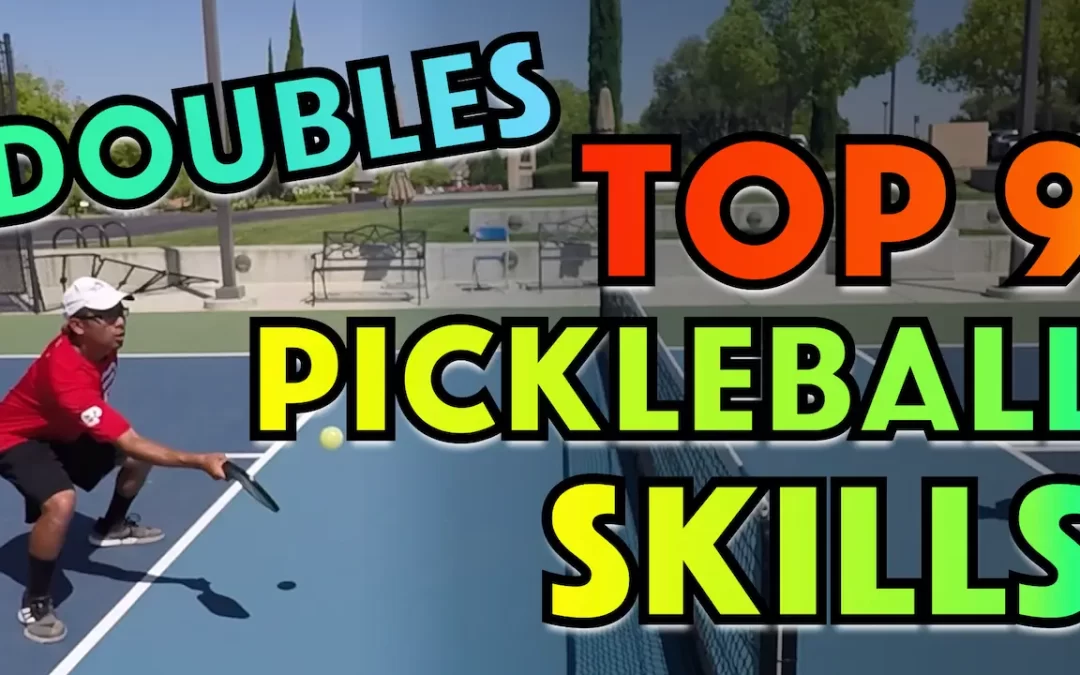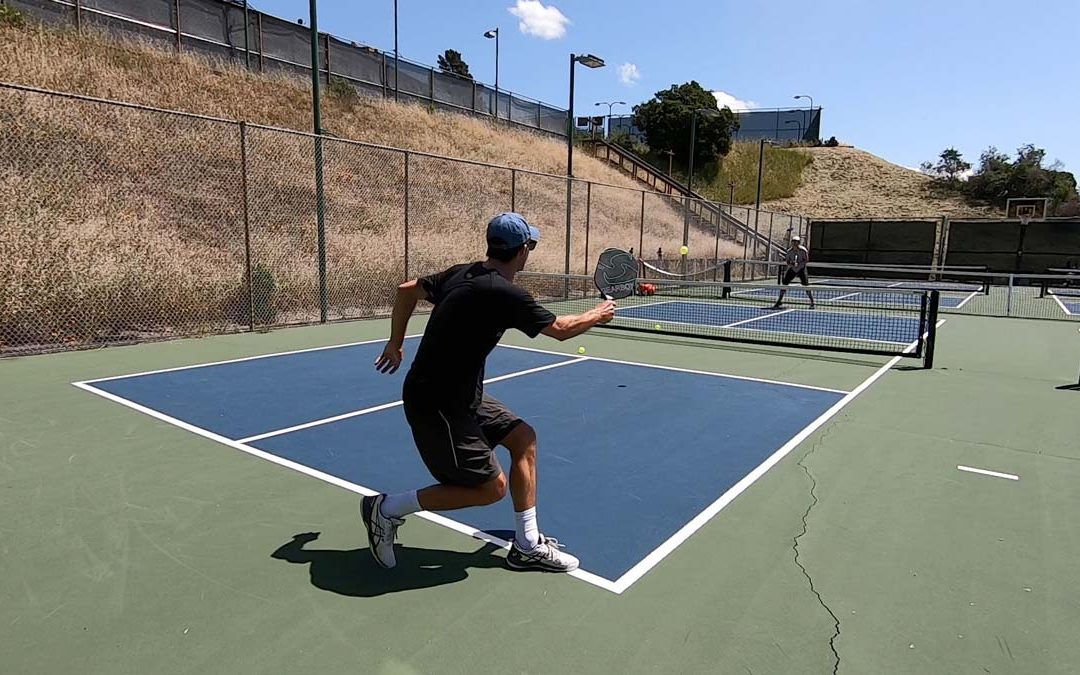Pickleball is a simple game but has some rules that can confuse beginners. It appears that the double bounce rule is one of those rules. It is also called the Two-Bounce rule, making it that much more confusing at first.
There are some minor details to learn to make it easy to remember this rule.
Want to learn some easy tips and tricks to remember the Pickleball double bounce rule?
What is the Pickleball Double Bounce Rule?
This rule starts with the first two shots of the game. It is achieved by the serve and the return of the serve, letting the ball bounce after each of those to shots is struck.
Once the receiver and the server have allowed the ball to bounce once on each side, the double bounce rule has been achieved, and play continues with either a volley (shot take out of the air) or groundstroke (ball bounces before your strike it).
Who Invented the Double Bounce Rule?
Pickleball was invented in 1965 by two fathers, Joe Pritchard and Bill Bell. They created the paddle sport on their backyard badminton-sized court to entertain their children on the long summer days.
While we know how the game started and rules in pickleball were drawn out by these two fathers to make the game fair for all of the family, we do not know the specifics of the double bounce rule. It may have been part of the initial game rules, but we may never know its true origins.
Why Does the Double Bounce Rule Exist?
If you’re a beginner at pickleball, this rule can be confusing, and if you have been playing other racquet sports, this rule will initially drive you a bit crazy. I must admit that I struggled with it at first coming from a tennis background. I would routinely want to volley the 3rd shot.
It goes against everything you learned, and you will want to take the ball out of the air at times that you are not allowed to.
There is a reason for this rule, and you will likely come learn to appreciate this rule, like I did, and come to be happy that it exists and allows for more extended points.
Reason Behind the Double Bounce Rule
With this basic rule, pickleball friends can enjoy the longer rallies of this great game, unlike the game of ping-pong and tennis where the double bounce rule does not apply.
It prevents the server and the server’s partner from crashing the net immediately after the serve which would put them in an extremely advantageous position to end the point quickly. Especially if the server has an exceptionally good serve that would lead to frequent weak return of serves.
This is counter to tennis and most other racquet sports where the serving team is permitted to crash the net immediately after the serve.
So, the double bounce rule:
- Somewhat evens the competition level
- It prevents the serving and returning team from being extremely aggressive on the first two shots of a point.
The Official Rule Book
The Two-Bounce Rule from the official pickleball tournament rule book states the following:
- When the ball is served, the receiving team must let it bounce before returning, and then the serving team must let it bounce before returning, thus two bounces.
- After the ball has bounced once in each team’s court, both teams may either volley the ball (hit the ball before it bounces) or play it off a bounce (ground stroke).
- The two-bounce rule eliminates the serve and volley advantage and extends rallies.
The Serve and The Return
The server must hit their serve to the half of the court diagonal to them and beyond the non-volley zone line. The receiving player must let the ball bounce once and return to the serving team’s side.
The serving side will then allow the ball to bounce once and return the ball to the receiving players. Then, anything goes, and any play on the ball can be made (before or after the bounce) until the next serve.
This rule eliminates the serve and volley advantage and extends each rally.
Doubles Team Example of the Double Bounce Rule
Two teams are prepared to play a game, Team A and Team B. They have flipped a coin and decided Team B will start as the serving team.
The player from Team B stands on the right-hand side of the pickleball court behind the baseline. The server announces 0,0,2 as the score and prepares to serve the ball.
He is standing behind the baseline, roughly in the middle of the side he is serving from, and using an underhand stroke with a below the waist contact point to serve.
The ball goes to the diagonal player’s court on the receiving team (Team A). The receiving player on Team A stands far back in the court and allows the ball to bounce once (the first bounce rule in pickleball), then hits it back aggressively forcing the opponent to drop back as it lands near the baseline.
A deep return! This is an excellent pickleball strategy.
The player on Team B allows the ball to bounce once before making paddle contact with the ball (the second bounce of the double bounce rule). He was standing near the back of the court so had to drop back a little in order to allow for the bounce which he is required to do if he doesn’t want to lose the point.
He is able to connect with the ball after the bounce and send it back over the net and in play. The two teams proceed to have have a back and forth exchange. This is also called a rally or a point (regardless of whether or not a point is ultimately scored)
Pro tip: Only the serving team can score a point
Finally, team A hits the ball in play but Team B is not able to return it. So, no points for Team B or Team A.
A sideout has occurred and now the serve goes over to the Team A player on the right-hand side of the court (remember the First Server Exception).
Sideout: the right to start the point with a serve transfers to the opposing team. That team now has a chance to win points until the next sideout occurs.
First Server Exception
This is a basic Pickleball rule. It states that the first server of the pickleball game will be the only player on that team to serve during that team’s first turn to be the serving team. After each of the remaining sideouts, each player on the team will have the opportunity to serve
The server on Team A announces the score 0,0,1 and serves the ball to Team B’s diagonally (cross-court) player.
The returner on Team B stands far back in the court and allows the ball to bounce once (the first bounce), then hits it back to the serving Team A, and she enables it to bounce once (the second bounce) and play continues.
Team B misses the ball again. Team A scores a point.
Team A server moves to the left of the court and announces 1,0,1 and serves the ball.
They complete the double-bounce rule, and the game continues until a team achieves 11 points with a 2-point lead and wins the game.
Beginner Tips for Mastering the Double Bounce Rule
Singles Game – Returner Side Tips
The first and easiest way to remember this rule is to start by standing behind the baseline when you expect the serve from the serving team. Several feet behind it may be necessary if the server routinely hits their serve deep.
When you stand toward the back of the court like this, you will be less tempted to take the ball before the bounce because it would be quite tough to do so from that position.
You’ll want to advance towards the net immediately after your return of serve (which you only hit after the bounce) to gain a strategic advantage in the point.
Singles Game – Server Side Tips
The two-bounce rule is more problematic for the server than the returner because in other sports the first bounce part of the rule is common but the second bounce part of the rule is not.
Once you serve you’ll want to stay back behind the baseline to enable the ball to bounce in front of you, even if it’s well hit and deep, once it is returned by the receiver.
This means you don’t want to advance into the court because you risk getting caught in a bad spot if they are able to hit the return near the baseline which would be behind you at that point. To deal with a bounce behind you is very problematic and chances are you won’t make that shot.
Doubles Game Tips
Both players on the serving team will start behind the baseline to accommodate for the second bounce of the two bounce rule. The server and the server’s partner should both help to remind the server’s partner to start the point from behind the baseline since they are more susceptible to getting caught by the rule than the server.
The receiver’s partner can start up at the non-volley zone line and is the only player on the court that can take their first shot in the point as a volley since they will only be able to hit the 4th shot of the point as their first shot in the point. They should capitalize on this by starting up in the court at the very start of the point.
The two- bounce rule is more likely to be a problem for the serving team than it is for the returning team because the serving team is responsible for the second bounce so they can’t be as aggressive in the point as they may like to be until the 5th shot.
Final Thoughts
We have learned a lot about the pickleball Double Bounce Rule. A few key takeaways are:
- When the ball is served, the receiving team must let it bounce before returning, and then the serving team must let it bounce before returning, thus two bounces.
- This rule extends the rally, and an excellent pickleball game is designed around strategically played rallies.
Enjoy this action-packed game of Pickleball with your new pickleball friends.
Hope to see you on the court someday!
Related Questions
Is Pickleball the Only Sport with the Double Bounce Rule?
This is one rule that makes the sport of pickleball unique. It is the only paddle (under the general paddle/racquet umbrella) game that requires the double bounce rule, making the rallies fun and competitive.
Are the Double Bounce and Two-Bounce Rule the same?
Yes, these are the same pickelball rules. In 2018 the official pickleball game rule book changed the name from double bounce rule to the two-bounce rule.
Therefore, it is the same rule no matter which term you use.
Does That Mean the Ball Can Bounce Twice?
Well, yes and no – the ball does bounce once on each court side, the receiving and the serving side – so two bounces. Though it cannot bounce twice on the same side of the court. That would be a fault and the team that allows that to happen loses the rally (point).






